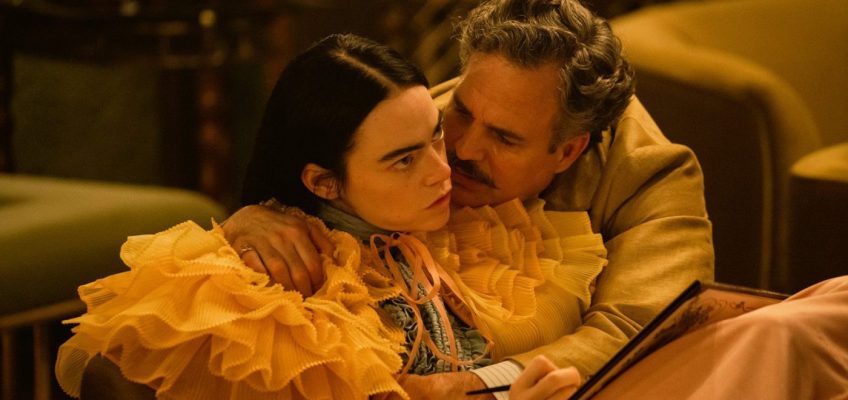In the middle of “Poor Things,” the new film from Oscar-nominated oddball auteur Yorgos Lanthimos, our heroine Bella Baxter (Emma Stone) toddles off on a solo adventure for the very first time. Wandering the streets of a pastel storybook Lisbon in silky shorts and a blouse with enormous puff sleeves, her long mane of raven hair swaying down back, Bella heads for a pastry stand, where she crams as many custard tarts as she can into her mouth. Later, she vomits them up on a balcony overlooking a picturesque vista of the city. Cause, meet effect. Bella observes this bit of data and reports it back to her scientist father figure, Godwin Baxter (Willem Dafoe) in a crudely scrawled postcard home.
This kind of self-experimentation is the backbone of “Poor Things,” Lanthimos’ strange and ravishing masterpiece about a young woman who receives one of life’s rare gifts: a chance to start over, from scratch. What will Bella do with her new lease on life? She’ll devour every last crumb, without an ounce of shame.
This adaptation of the 1992 novel by the late Scottish writer Alasdair Gray (the script is by “The Favourite” scribe Tony McNamara) has long been a pet project of Lanthimos’, and it fits with themes he has explored in his other films, specifically “Dogtooth,” wherein adult innocents seek to escape cloistered confines. But Bella Baxter might be his most daring, and shockingly self-possessed, creation yet.
She is, in fact, the creation of Godwin, a brutally disfigured surgeon who was the subject of his own father’s medical meddling, who lives, teaches and researches in Victorian London. Godwin is a tender, loving figure, a Dr. Frankenstein whose ethereal waif of a monster is like a daughter to him. While her brain catches up to her body, she waddles around his house, stiff-legged and petulant, every step, bite and word carefully cataloged by a sweet young medical student named Max (Ramy Youssef).
Emma Stone in the movie “Poor Things.” (Atsushi Nishijima/Searchlight Pictures/20th Century Studios/TNS)
Despite his desire to keep the conditions of his experiment pure, Bella is a being of free will, and Godwin is just one of many guides in her personal evolution. He instills in her a love of science, but soon her burgeoning sexual appetite leads her astray, and Bella becomes taken with a dastardly cad named Duncan Wedderburn (a terrific heel turn from Mark Ruffalo), who whisks her away to Lisbon. Thus begins the adventure that makes Bella who she is, learning the highs and lows of life with the help of various characters who demonstrate to her what it means to be human: the corporeal pleasures, intellectual quandaries, emotional lows and political questions — and that people can be “cruel beasts,” too.
She gains philosophical and pragmatic knowledge aboard an ocean liner from Martha (Hanna Schygulla) and Harry (Jerrod Carmichael), and learns more about herself and others though sex work and socialism in Paris, under the tutelage of a madam named Swiney (Kathryn Hunter) and a new comrade (Suzy Bemba). The final stop on her experimental journey through the human condition is back home to London where she has to face herself, or the self that others expect her to be. Will she accept or reject it?
This image released by Searchlight Pictures shows Ramy Youssef, left, and Willem Dafoe in a scene from “Poor Things.” (Yorgos Lanthimos/Searchlight Pictures via AP)
There’s an obvious comparison to be made here to “Barbie,” another film about a beautiful naïf discovering the sharp corners of the world. But where Barbie cracks under her existential crisis, Bella only grows stronger, absorbing power as she explores more and more. Stone delivers the most astonishing performance, and is perhaps the only actress who could convincingly convey such simultaneous expressions of sincerity, absurdity, intelligence, libidinousness and humor.
Stone’s performance evokes modern dance and movement both avant-garde and primitive. While she incrementally evolves Bella before our eyes, Lanthimos evolves the film’s style alongside her, from the film stock and camera movements, to the gorgeously rendered production design by Shona Heath and James Price, to the elaborate costumes by Holly Waddington.
“Poor Things” was shot by Robbie Ryan on a variety of 35mm film stocks, starting with Bella’s “babyhood” in black and white, captured with wide-angle, often fish-eye lenses. English musician Jerskin Hendrix offers an eerie, keening musical theme that echoes throughout, as Bella embarks on her magical mystery tour through a child’s-eye view of Europe, detailed jewel-box sets captured in soft color. As her strides and words lengthen, the film grain changes, the color deepens, the camera fluidly following her maturation. It is at once subtle and obvious; it happens so smoothly it almost sneaks up on you, changing and growing in concert with its protagonist.
This image released by Searchlight Pictures shows Emma Stone in a scene from “Poor Things.” (Yorgos Lanthimos/Searchlight Pictures via AP)
This film may be fantastical, outré, at times bizarre, and sexually frank. But ultimately, “Poor Things” is a traditional heroine’s journey forging its own singular path. That Bella achieves a fully embodied sense of personal liberation makes it a truly radical — and feminist — fairy tale.
‘Poor Things’
4 stars (out of 4)
Running time: 2:21
MPA rating: R (for strong and pervasive sexual content, graphic nudity, disturbing material, gore and language)
How to watch: In theaters on Friday.
Related Articles
The top 10 best (and worst!) movies of 2023
7 must-read nonfiction graphic novels
Best TV of 2023: In a tumultuous year for Hollywood, standouts include Chicago-set ‘The Bear’ and Netflix’s ‘The Diplomat’
4 spirited cocktails for Hanukkah
Crazy about pickleball? Now you can check out padel in Mendota Heights


Leave a Reply